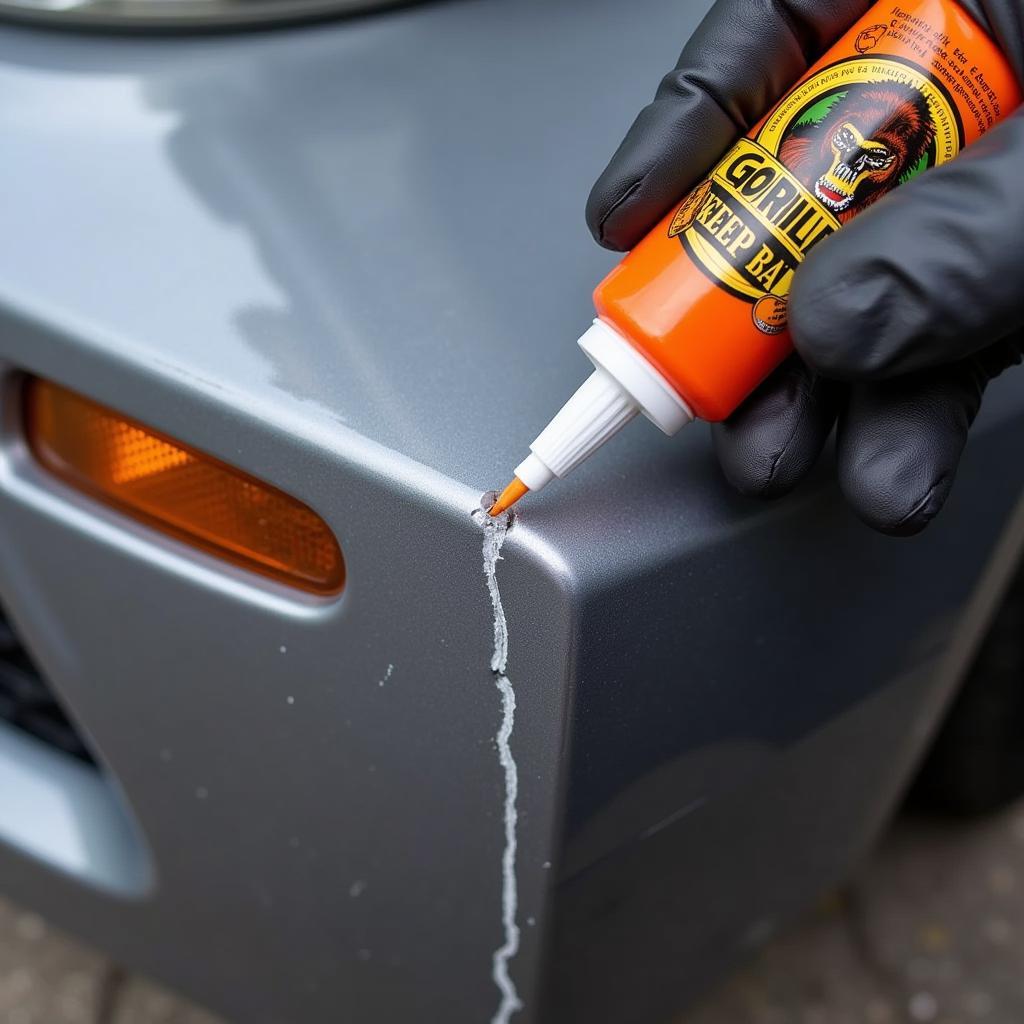Gorilla Weld is often touted as a miracle fix for everything from cracked engine blocks to broken plastic toys. But can this powerful adhesive really fix a plastic car bumper? Let’s delve into the world of bumper repair and find out if Gorilla Weld is the right tool for the job.  Gorilla Weld being applied to a cracked car bumper
Gorilla Weld being applied to a cracked car bumper
Understanding Bumper Damage and Repair Options
Before we determine the suitability of Gorilla Weld, it’s essential to understand the types of damage a car bumper can sustain. Bumper damage ranges from minor scratches and scuffs to deep cracks and dents. The repair method depends on the severity and type of damage. For minor scratches, a simple touch-up paint may suffice. Deeper scratches might require sanding and repainting. fixing plastic car body panels provides some insights into repairing various types of damage to plastic car body panels. However, for cracks and larger damage, more robust solutions are needed. This is where adhesives like Gorilla Weld come into the picture.
Can Gorilla Weld Fix Minor Bumper Cracks?
For hairline cracks and small chips, Gorilla Weld might be a viable option. Its strong adhesive properties can effectively bond the broken pieces together. However, proper preparation is crucial for successful repair. The surface must be thoroughly cleaned and any loose plastic fragments removed.
Gorilla Weld: Pros and Cons for Bumper Repair
Gorilla Weld offers several advantages when it comes to bumper repair. It’s incredibly strong, relatively inexpensive, and easy to apply.  Applying Gorilla Weld to a car bumper crack
Applying Gorilla Weld to a car bumper crack
However, there are also some drawbacks. Gorilla Weld is a permanent fix, meaning it’s difficult to remove once applied. It can also be messy to work with, requiring careful application and cleanup. Additionally, while Gorilla Weld can bond plastic, it might not provide the same flexibility as the original bumper material, making it susceptible to cracking again under stress.
“Gorilla Weld is a great tool for quick fixes, but it’s not a magic bullet,” says David Miller, an automotive engineer with over 20 years of experience. “Proper surface preparation and understanding the limitations of the adhesive are crucial for successful repair.”
How to Use Gorilla Weld on a Plastic Car Bumper?
If you decide to use Gorilla Weld for your bumper repair, follow these steps:
- Clean the damaged area thoroughly with soap and water.
- Sand the area around the crack or damage to create a rough surface for better adhesion.
- Mix the two parts of the Gorilla Weld epoxy according to the manufacturer’s instructions.
- Apply the epoxy to the damaged area, ensuring complete coverage and a strong bond.
- Allow the epoxy to cure completely before sanding and painting the repaired area.
Alternative Bumper Repair Solutions
Apart from Gorilla Weld, other solutions exist for repairing plastic bumpers. fix car bumper with tape describes the use of specialized tapes for temporary repairs. Plastic welding is another option, offering a more permanent and flexible repair for larger cracks and damage. Professional body shops can also perform repairs using specialized tools and techniques.
Choosing the Right Repair Method
The optimal repair method depends on several factors, including the severity of the damage, your budget, and your DIY skills. For minor scratches and cracks, Gorilla Weld or specialized tapes can be effective. However, for more extensive damage, professional repair might be necessary.
Conclusion: Is Gorilla Weld the Right Choice?
Gorilla Weld can be an effective solution for fixing minor cracks and damage on plastic car bumpers. However, it’s essential to consider the limitations of the adhesive and the type of damage you’re dealing with. For extensive damage, professional repair is always recommended. For any further assistance or inquiries about car repair solutions, feel free to contact AutoTipPro at +1 (641) 206-8880 or visit our office at 500 N St Mary’s St, San Antonio, TX 78205, United States.
“While Gorilla Weld can be a handy solution, remember that it’s not a replacement for professional repair,” adds Sarah Johnson, an experienced auto body technician. “For significant damage or structural issues, consulting a professional is crucial for ensuring the safety and longevity of your vehicle.”
FAQ
-
What is Gorilla Weld? Gorilla Weld is a two-part epoxy adhesive known for its strong bonding properties.
-
Is Gorilla Weld permanent? Yes, Gorilla Weld creates a permanent bond.
-
Can I paint over Gorilla Weld? Yes, you can sand and paint over Gorilla Weld after it has cured completely.
-
What are the alternatives to Gorilla Weld for bumper repair? Alternatives include plastic welding, specialized tapes, and professional body shop repair.
-
How long does Gorilla Weld take to cure? Gorilla Weld typically cures within 1-2 hours, but full strength is achieved after 24 hours.
-
Is Gorilla Weld flexible? While Gorilla Weld is strong, it’s not as flexible as some other plastic repair methods.
-
Where can I buy Gorilla Weld? Gorilla Weld is available at most hardware stores and online retailers.




Leave a Reply